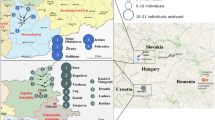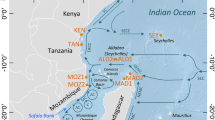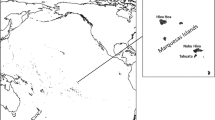Abstract
Indonesia, an island nation linking mainland Asia with the Pacific world, hosts a wide range of linguistic, ethnic and genetic diversity. Despite the complexity of this cultural environment, genetic studies in Indonesia remain surprisingly sparse. Here, we report mitochondrial DNA (mtDNA) and associated Y-chromosome diversity for the largest cohort of Indonesians examined to date—2740 individuals from 70 communities spanning 12 islands across the breadth of the Indonesian archipelago. We reconstruct 50 000 years of population movements, from mitochondrial lineages reflecting the very earliest settlers in island southeast Asia, to Neolithic population dispersals. Historic contacts from Chinese, Indians, Arabs and Europeans comprise a noticeable fraction of Y-chromosome variation, but are not reflected in the maternally inherited mtDNA. While this historic immigration favored men, patterns of genetic diversity show that women moved more widely in earlier times. However, measures of population differentiation signal that Indonesian communities are trending away from the matri- or ambilocality of early Austronesian societies toward the more common practice of patrilocal residence today. Such sex-specific dispersal patterns remain even after correcting for the different mutation rates of mtDNA and the Y chromosome. This detailed palimpsest of Indonesian genetic diversity is a direct outcome of the region’s complex history of immigration, transitory migrants and populations that have endured in situ since the region’s first settlement.
Similar content being viewed by others
Log in or create a free account to read this content
Gain free access to this article, as well as selected content from this journal and more on nature.com
or
Accession codes
References
Lewis, M. P. Ethnologue: Languages of the World (SIL International, Dallas, TX, USA, 2009).
Pawley, A. The chequered career of the Trans New Guinea hypothesis: Recent research and its implications In Papuan Pasts: Cultural, Linguistic and Biological Histories of Papuan-Speaking Peoples (eds Pawley A., Attenborough R., Golson J. & Hide R.) 67–107 (Pacific Linguistics, Canberra, 2005).
Bellwood, P. Prehistory of the Indo-Malaysian Archipelago (Australian National University, Canberra, 2007).
Barker, G. The archaeology of foraging and farming at Niah Cave, Sarawak. Asian Perspect. 44, 90–106 (2005).
Barker, G., Barton, H., Bird, M., Daly, P., Datan, I., Dykes, A. et al. The ‘human revolution’ in lowland tropical Southeast Asia: the antiquity and behavior of anatomically modern humans at Niah Cave (Sarawak, Borneo). J. Hum. Evol. 52, 243–261 (2007).
Rasmussen, M., Guo, X., Wang, Y., Lohmueller, K. E., Rasmussen, S., Albrechtsen, A. et al. An Aboriginal Australian genome reveals separate human dispersals into Asia. Science 334, 94–98 (2011).
Mellars, P. A new radiocarbon revolution and the dispersal of modern humans in Eurasia. Nature 439, 931–935 (2006).
Mellars, P. Going east: new genetic and archaeological perspectives on the modern human colonization of Eurasia. Science 313, 796–800 (2006).
O’Connell, J. F. & Allen, J. Dating the colonization of Sahul (Pleistocene Australia–New Guinea): a review of recent research. J. Archaeol. Sci. 31, 835–853 (2004).
Gray, R. D., Drummond, A. J. & Greenhill, S. J. Language phylogenies reveal expansion pulses and pauses in Pacific settlement. Science 323, 479–483 (2009).
Jordan, F. M., Gray, R. D., Greenhill, S. J. & Mace, R. Matrilocal residence is ancestral in Austronesian societies. Proc. R. Soc. B 276, 1957–1964 (2009).
Currie, T. E., Greenhill, S. J., Gray, R. D., Hasegawa, T. & Mace, R. Rise and fall of political complexity in island south-east Asia and the Pacific. Nature 467, 801–804 (2010).
Bellwood, P. The First Farmers: The Origins of Agricultural Societies (Blackwell Publishing, Oxford, 2005).
Oppenheimer, S. Eden in the East: The Drowned Continent of Southeast Asia (Phoenix, London, 1999).
Oppenheimer, S. J. & Richards, M. Polynesian origins. Slow boat to Melanesia? Nature 410, 166–167 (2001).
Cox, M. P. Indonesian mitochondrial DNA and its opposition to a Pleistocene era origin of proto-Polynesians in Island Southeast Asia. Hum. Biol. 77, 179–188 (2005).
Cox, M. P. The genetic environment of Melanesia: Clines, clusters and contact In Population Genetics Research Progress (ed. Koven V. T.) 45–83 (Nova Science Publishers, New York, 2008).
Cox, M. P. & Lahr, M. M. Y-Chromosome diversity is inversely associated with language affiliation in paired Austronesian- and Papuan-speaking communities from Solomon Islands. Am. J. Hum. Biol. 18, 35–50 (2006).
Cox, M. P., Redd, A. J., Karafet, T. M., Ponder, C. A., Lansing, J. S., Sudoyo, H. et al. A Polynesian motif on the Y chromosome: population structure in Remote Oceania. Hum. Biol. 79, 525–535 (2007).
Karafet, T. M., Hallmark, B., Cox, M. P., Sudoyo, H., Downey, S. S., Lansing, J. S. et al. Major east-west division underlies Y chromosome stratification across Indonesia. Mol. Biol. Evol. 27, 1833–1844 (2010).
Karafet, T. M., Lansing, J. S., Redd, A. J., Reznikova, S., Watkins, J. C., Surata, S. P. et al. Balinese Y-chromosome perspective on the peopling of Indonesia: genetic contributions from pre-Neolithic hunter-gatherers, Austronesian farmers, and Indian traders. Hum. Biol. 77, 93–114 (2005).
Kayser, M. The human genetic history of Oceania: near and remote views of dispersal. Curr. Biol. 20, R194–R201 (2010).
Kayser, M., Brauer, S., Cordaux, R., Casto, A., Lao, O., Zhivotovsky, L. A. et al. Melanesian and Asian origins of Polynesians: mtDNA and Y-chromosome gradients across the Pacific. Mol. Biol. Evol. 23, 2234–2244 (2006).
Kayser, M., Brauer, S., Weiss, G., Schiefenhövel, W., Underhill, P., Shen, P. et al. Reduced Y-chromosome, but not mitochondrial DNA, diversity in human populations from West New Guinea. Am. J. Hum. Genet. 72, 281–302 (2003).
Hill, C., Soares, P., Mormina, M., Macaulay, V., Clarke, D., Blumbach, P. B. et al. A mitochondrial stratigraphy for island southeast Asia. Am. J. Hum. Genet. 80, 29–43 (2007).
Soares, P., Trejaut, J. A., Loo, J.-H., Hill, C., Mormina, M., Lee, C.-L. et al. Climate change and postglacial human dispersals in Southeast Asia. Mol. Biol. Evol. 25, 1209–1218 (2008).
Cox, M. P., Karafet, T. M., Lansing, J. S., Sudoyo, H. & Hammer, M. F. Autosomal and X-linked single nucleotide polymorphisms reveal a steep Asian-Melanesian ancestry cline in eastern Indonesia and a sex bias in admixture rates. Proc. R. Soc. B 277, 1589–1596 (2010).
HUGO Pan-Asian SNP Consortium. Mapping human genetic diversity in Asia. Science 326, 1541–1545 (2009).
Wollstein, A., Lao, O., Becker, C., Brauer, S., Trent, R. J., Nürnberg, P. et al. Demographic history of Oceania inferred from genome-wide data. Curr. Biol. 20, 1983–1992 (2010).
Yao, Y. G., Kong, Q. P., Bandelt, H. J., Kivisild, T. & Zhang, Y. P. Phylogeographic differentiation of mitochondrial DNA in Han Chinese. Am. J. Hum. Genet. 70, 635–651 (2002).
Allard, M. W., Wilson, M. R., Monson, K. L. & Budowle, B. Control region sequences for East Asian individuals in the Scientific Working Group on DNA Analysis Methods forensic mtDNA data set. Leg. Med. 6, 11–24 (2004).
Li, H., Cai, X., Winograd-Cort, E. R., Wen, B., Cheng, X., Qin, Z. et al. Mitochondrial DNA diversity and population differentiation in southern East Asia. Am. J. Phys. Anthropol. 134, 481–488 (2007).
Hill, C., Soares, P., Mormina, M., Macaulay, V., Meehan, W., Blackburn, J. et al. Phylogeography and ethnogenesis of aboriginal southeast Asians. Mol. Biol. Evol. 23, 2480–2491 (2006).
Trejaut, J. A., Kivisild, T., Loo, J. H., Lee, C. L., He, C. L., Hsu, C. J. et al. Traces of archaic mitochondrial lineages persist in Austronesian-speaking Formosan populations. PLoS Biol. 3, e247 (2005).
Friedlaender, J. S., Friedlaender, F. R., Hodgson, J. A., Stoltz, M., Koki, G., Horvat, G. et al. Melanesian mtDNA complexity. PLoS ONE 2, e248 (2007).
Tabbada, K. A., Trejaut, J., Loo, J.-H., Chen, Y.-M., Lin, M., Mirazón-Lahr, M. et al. Philippine mitochondrial DNA diversity: a populated viaduct between Taiwan and Indonesia? Mol. Biol. Evol. 27, 21–31 (2010).
Miller, S. A., Dykes, D. D. & Polesky, H. F. A simple salting out procedure for extracting DNA from human nucleated cells. Nucleic Acids Res. 16, 1215 (1988).
Andrews, R. M., Kubacka, I., Chinnery, P. F., Lightowlers, R. N., Turnbull, D. M. & Howell, N. Reanalysis and revision of the Cambridge reference sequence for human mitochondrial DNA. Nat. Genet. 23, 147 (1999).
Tanaka, M., Cabrera, V. M., Gonzalez, A. M., Larruga, J. M., Takeyasu, T., Fuku, N. et al. Mitochondrial genome variation in eastern Asia and the peopling of Japan. Genome Res. 14, 1832–1850 (2004).
Kong, Q. P., Yao, Y. G., Sun, C., Bandelt, H. J., Zhu, C. L. & Zhang, Y. P. Phylogeny of east Asian mitochondrial DNA lineages inferred from complete sequences. Am. J. Hum. Genet. 73, 671–676 (2003).
Friedlaender, J., Gentz, F., Friedlaender, F., Kaestle, F., Schurr, T., Koki, G. et al. Mitochondrial genetic diversity and its determinants in Island Melanesia In Papuan Pasts: Cultural, Linguistic and Biological Histories of Papuan-Speaking Peoples (eds Pawley, A., Attenborough, R., Golson, J. & Hide, R.) 693–716 (Pacific Linguistics, Canberra, 2005).
van Oven, M. Revision of the mtDNA tree and corresponding haplogroup nomenclature. PNAS 107, E38–E39 (2010).
Excoffier, L. & Lischer, H. E. L. Arlequin suite ver 3.5: a new series of programs to perform population genetics analyses under Linux and Windows. Mol. Ecol. Res. 10, 564–567 (2010).
Slatkin, M. Inbreeding coefficients and coalescence times. Genet. Res. Camb. 58, 167–175 (1991).
Slatkin, M. A measure of population subdivision based on microsatellite allele frequencies. Genetics 139, 457–462 (1995).
R Development Core Team R: A Language and Environment for Statistical Computing (2012). http://www.r-project.org/.
Bandelt, H. J., Forster, P. & Röhl, A. Median-joining networks for inferring intraspecific phylogenies. Mol. Biol. Evol. 16, 37–48 (1999).
Forster, P., Harding, R., Torroni, A. & Bandelt, H.-J. Origin and evolution of native American mtDNA variation: a reappraisal. Am. J. Hum. Genet. 59, 935–945 (1996).
Soares, P., Ermini, L., Thomson, N., Mormina, M., Rito, T., Röhl, A. et al. Correcting for purifying selection: an improved human mitochondrial molecular clock. Am. J. Hum. Genet. 84, 740–759 (2009).
Cox, M. P. Accuracy of molecular dating with the rho statistic: deviations from coalescent expectations under a range of demographic models. Hum. Biol. 80, 335–357 (2008).
Hedrick, P. W. A standardized genetic differentiation measure. Evolution 59, 1633–1638 (2005).
van Oven, M., Hämmerle, J. M., van Schoor, M., Kushnick, G., Pennekamp, P., Zega, I. et al. Unexpected island effects at an extreme: reduced Y-chromosome and mitochondrial DNA diversity in Nias. Mol. Biol. Evol. 28, 1349–1361 (2011).
Cox, M. P., Nelson, M. G., Tumonggor, M. K., Ricaut, F. X. & Sudoyo, H. A small cohort of Island Southeast Asian women founded Madagascar. Proc. R. Soc. B 279, 2761–2768 (2012).
Razafindrazaka, H., Ricaut, F.-X., Cox, M. P., Mormina, M., Dugoujon, J.-M., Randriamarolaza, L. P. et al. Complete mitochondrial DNA sequences provide new insights into the Polynesian motif and the peopling of Madagascar. Eur. J. Hum. Genet. 18, 575–581 (2010).
Macaulay, V., Hill, C., Achilli, A., Rengo, C., Clarke, D., Meehan, W. et al. Single, rapid coastal settlement of Asia revealed by analysis of complete mitochondrial genomes. Science 308, 1034–1036 (2005).
Dupuy, B. M., Stenersen, M., Egeland, T. & Olaisen, B. Y-chromosomal microsatellite mutation rates: differences in mutation rate between and within loci. Hum. Mutat. 23, 117–124 (2004).
Fenner, J. N. Cross-cultural estimation of the human generation interval for use in genetics-based population divergence studies. Am. J. Phys. Anthropol. 128, 415–423 (2005).
Gusmão, L., Sánchez-Diz, P., Calafell, F., Martín, P., Alonso, C. A., Álvarez-Fernández, F. et al. Mutation rates at Y chromosome specific microsatellites. Hum. Mutat. 26, 520–528 (2005).
Zhivotovsky, L. A., Underhill, P. A., Cinnioğlu, C., Kayser, M., Morar, B., Kivisild, T. et al. The effective mutation rate at Y chromosome short tandem repeats, with application to human population-divergence time. Am. J. Hum. Genet. 74, 50–61 (2004).
Lansing, J. S., Karafet, T. M., Schoenfelder, J. & Hammer, M. F. A DNA signature for the expansion of irrigation in Bali? In Past Human Migrations in East Asia: Matching Archaeology, Linguistics and Genetics (eds Sanchez-Mazas, A., Blench, R., Ross, M. D., Peiros, I. & Lin, M.) 377–395 (Routledge, London, 2008).
Blust, R. The Austronesian Languages. Research School of Pacific and Asian Studies. (Australian National University, Canberra, Australia, 2009).
Oppenheimer, S. & Richards, M. Fast trains, slow boats, and the ancestry of the Polynesian Islanders. Sci. Prog. 84, 157–181 (2001).
Jinam, T. A., Hong, L.-C., Phipps, M. E., Stoneking, M., Ameen, M., Edo, J. et al. Evolutionary history of continental southeast Asians: ‘Early train’ hypothesis based on genetic analysis of mitochondrial and autosomal DNA data. Mol. Biol. Evol 29, 3513–3527 (2012).
Soares, P., Rito, T., Trejaut, J., Mormina, M., Hill, C., Tinkler-Hundal, E. et al. Ancient voyaging and Polynesian origins. Am. J. Hum. Genet. 88, 239–247 (2011).
Forster, P., Torroni, A., Renfrew, C. & Röhl, A. Phylogenetic star contraction applied to Asian and Papuan mtDNA evolution. Mol. Biol. Evol. 18, 1864–1881 (2001).
Ross, M. Pronouns as a preliminary diagnostic of grouping Papuan languages In Papuan Pasts: Cultural, Linguistic and Biological Histories of Papuan-Speaking Peoples (eds Pawley, A., Attenborough, R., Golson, J. & Hide R.) 15–65 (Pacific Linguistics, Canberra, 2005).
Xu, S., Pugach, I., Stoneking, M., Kayser, M., Jin, L. & the HUGO Pan-Asian SNP Consortium. Genetic dating indicates that the Asian-Papuan admixture through Eastern Indonesia corresponds to the Austronesian expansion. Proc. Natl Acad. Sci. USA 109, 4574–4579 (2012).
Gray, R. D. & Jordan, F. M. Language trees support the express-train sequence of Austronesian expansion. Nature 405, 1052–1054 (2000).
Hage, P. & Marck, J. Matrilineality and the Melanesian origin of Polynesian Y chromosomes. Curr. Anthropol. 44, S121–S127 (2003).
Lansing, S. J., Cox, M. P., de Vet, T. A., Downey, S. S., Hallmark, B. & Sudoyo, H. An ongoing Austronesian expansion in Island Southeast Asia. J. Anthropol. Archaeol. 30, 262–272 (2011).
Tibbetts, G. A Study of the Arabic Texts Containing Material on South-East Asia (E. J. Brill, Leiden, 1979).
Acknowledgements
This research was supported by a US National Science Foundation grant (SES 0725470) to JSL, MFH, TMK, and Joe C. Watkins, which funded the doctoral research of MKT. The Royal Society of New Zealand provided support through a Rutherford Fellowship (RDF-10-MAU-001) and Marsden Grant (11-MAU-007) to MPC.
Author information
Authors and Affiliations
Corresponding author
Additional information
Supplementary Information accompanies the paper on Journal of Human Genetics website
Supplementary information
Rights and permissions
About this article
Cite this article
Tumonggor, M., Karafet, T., Hallmark, B. et al. The Indonesian archipelago: an ancient genetic highway linking Asia and the Pacific. J Hum Genet 58, 165–173 (2013). https://doi.org/10.1038/jhg.2012.154
Received:
Revised:
Accepted:
Published:
Issue date:
DOI: https://doi.org/10.1038/jhg.2012.154
Keywords
This article is cited by
-
Does Ethnicity Affect Ever Migrating and the Number of Migrations? The Case of Indonesia
European Journal of Population (2024)
-
Ancient genomes from the last three millennia support multiple human dispersals into Wallacea
Nature Ecology & Evolution (2022)
-
Association of FTO rs1421085 single nucleotide polymorphism with fat and fatty acid intake in Indonesian adults
BMC Research Notes (2021)
-
Genetic diversity and population structure of ridge gourd (Luffa acutangula) accessions in a Thailand collection using SNP markers
Scientific Reports (2021)
-
The Ami and Yami aborigines of Taiwan and their genetic relationship to East Asian and Pacific populations
European Journal of Human Genetics (2021)



